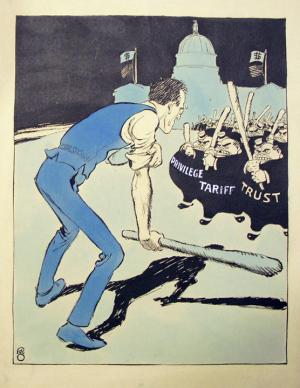Cooper designed this political cartoon in response to Woodrow Wilson (1856-1924) and his 1913 “triple wall of privilege,” which sought to reorganize the tariffs, the banks, and the trusts in the United States. During the first year of his presidency, Wilson proposed the Underwood Tariff Bill to help lower the general rate from about 40% to 26%. This led to the first American income tax, based on a graduated scale that started on incomes over $3000. Wilson also put into place the Federal Reserve Act, with a Federal Reserve Bank in each of twelve regions. Finally, he focused on the reorganization of trusts and after much convincing, the Clayton Anti-Trust Act of 1914 was passed banning price discrimination.
Fred G. Cooper was born in Oregon and educated at the Mark Hopkins Art Institute in San Francisco, before moving to New York City in 1904 to find work as a freelance artist. He created designs for New York Edison (or ConEd), Westinghouse, and the U.S. War Department, among many others. This cartoon was probably for Life magazine, where he contributed drawings from 1904 to the 1930’s, although I have not yet found the issue.
(btw: The year after this cartoon was published, Cooper was one of fourteen graphic artists to form the American Institute of Graphic Arts (AIGA), along with Frederic W. Goudy, Hal Marchbanks, and William Edwin Rudge. The only membership requirement, besides $25 dues, was that each member had to buy his own Windsor chair.)
